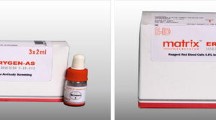Abstract
We have analyzed the method used in our laboratory to detect the most elusive, clinically significant alloantibody: the Kidd alloantibodies and find the most convenient procedure. A retrospective analysis of the method used in our laboratory for determining Kidd alloantibodies from January 2013 to May 2015 was conducted. The details of the event that sensitized the patient for red cell antibody formation and procedure used to detect the alloantibody were retrieved from the departmental records. Of 405 red cell antibody identification cases, 24 (5.9 %) had Kidd antibody (anti-Jka in 12: 50 % cases; anti-Jkb in 4: 16.7 % cases; multiple antibodies in 8: 32 % cases). Thirteen of 24 patients (54.2 %) had autocontrol positive of which 6 cases needed adsorption procedures whereas antibody/ies could be identified without adsorption procedure in the remaining 7 cases. All the 7 cases had autocontrol of 1+ strength. Of the 11 patients (45.8 %) with autocontrol negative, the antibody was identified using solid phase in 7 cases whereas tube panels were also used in the remaining 4 cases. Kidd alloantibodies though deceptive can be identified by sensitive techniques like the solid phase and simple but laborious techniques using the tube cell panels. Depending upon the reaction strength of the autocontrol, the routine autoadsorption process may be skipped and tube cell enzyme treated cells or solid phase techniques be used to get the results.



Similar content being viewed by others
References
Storry JR (2014) Other blood group systems and antigens. In: Fung MK, Grossman BJ, Hillyer CD, Westhoff CM (eds) Technical manual, 18th edn. American Association of Blood Banks, Bethesda, pp 337–363
Klein HG, Anstee DJ (2014) Other red cell antigens. In: Klein HG, Anstee DJ (eds) Mollison’s blood transfusion in clinical medicine, 12th edn. Wiley Blackwell, Oxford, pp 214–258
Leger RM (2012) Blood group terminology and other blood groups. In: Harmening DM (ed) Modern blood banking & transfusion practices, 6th edn. F. A. Davis Company, Philadelphia, pp 172–215
Immucor Inc. W.A.R.M. manufacturer’s package insert. Package insert code 0057319: Revised in October 2011
Fung MK, Grossman BJ, Hillyer CD, Westhoff CM (eds) (2014) Technical manual, 18th edn. American Association of Blood Banks, Bethesda
Trudell KS (2012) Detection and identification of antibodies. In: Harmening DM (ed) Modern blood banking & transfusion practices, 6th edn. F. A. Davis Company, Philadelphia, pp 216–237
Nguyen DM, Lee HJ, Mirabella D, Wu DW (2010) Delayed hemolytic transfusion reaction due to anti-Jkb: case report highlighting the importance of early blood bank consultation and literature review. N Am J Med Sci 3(4):187–193
Pineda AA, Taswell HF, Brzica SM (1978) Transfusion reaction. An immunologic hazard of blood transfusion. Transfusion 18:1–7
Ness PM, Shirey RS, Thoman SK, Buck SA (1990) The differentiation of delayed serologic and delayed hemolytic transfusion reactions: incidence, long-term serologic findings, and clinical significance. Transfusion 30:688–693
Morgan P, Wheeler CB, Bossom EL (1967) Delayed transfusion reaction attributed to anti-Jkb. Transfusion 7:307–308
Holland PV, Wallerstein RO (1968) Delayed hemolytic transfusion reaction with acute renal failure. JAMA 204:1007–1008
Hussain SS, Ebbs AM, Curtin NJ, Keidan AJ (2007) Delayed haemolytic transfusion reaction due to anti-Jkb in a patient with non-Hodgkin’s lymphoma-transient nature of anti-Jkb and the importance of early serological diagnosis. Transfus Med 17(3):197–199
Geifman-Holtzman O, Wojtowycz M, Kosmas E, Artal R (1997) Female alloimmunization with antibodies known to cause hemolytic disease. Obstet Gynecol 89:272–275
Walker PS, Hamilton JR (2014) Other Blood group systems and antigens. In: Fung MK, Grossman BJ, Hillyer CD, Westhoff CM (eds) Technical manual, 18th edn. American Association of Blood Banks, Bethesda, pp 391–424
Author information
Authors and Affiliations
Corresponding author
Rights and permissions
About this article
Cite this article
Makroo, R.N., Nayak, S., Chowdhry, M. et al. Facts and Fallacies of Kidd Antibodies: Experience in a Tertiary Care Hospital in North India. Indian J Hematol Blood Transfus 33, 254–258 (2017). https://doi.org/10.1007/s12288-016-0678-7
Received:
Accepted:
Published:
Issue Date:
DOI: https://doi.org/10.1007/s12288-016-0678-7



